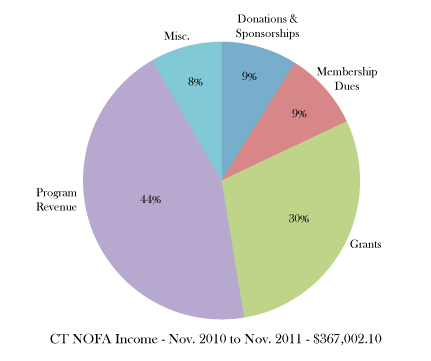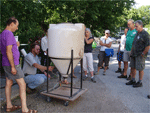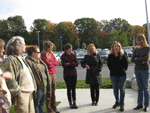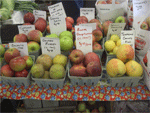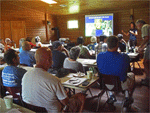In the aftermath of Winter Storm Albert, the piles of dead trees and tree limbs are accumulating along town roads. While Albert was a pretty unusual storm, it highlighted the importance of healthy, strong trees that are located in residential areas. Old trees aren't a liability if they are cared for properly - and I know the trees in my yard are an ecological staple, providing shade for shade gardens, cooling my house in the summer, habitat for my favorite birds and very entertaining squirrels, leaves that I use to mulch our gardens, kindling for my fireplace, and some less personal (but still vital) benefits like oxygen, erosion control, and flood control (woodland has been found to be 60 times more effective at absorbing water than grazed land and lawns).
Given all of these ecological services, trees are a central part of organic landscaping, and they are being celebrated as such in the
2011 NOFA Organic Land Care Annual Gathering.
Early bird registration has been extended until November 22 and arborists, landscapers, naturalists and all kinds of tree-enthusiasts are welcome to attend.
The line up:
Keynote: Tom Wessels
"Foundational Principles of Sustainability"
For 3.5 billion years life has not only sustained itself, but has
thrived on this planet. To create sustainable systems we don’t need to
reinvent the wheel, we only need to embrace the foundational scientific
principles that govern sustainability in all living systems. This
presentation covers three of these foundational principles: the law of
limits to growth, the second law of thermodynamics and its relationship
to entropy, and the law of self-organization. Examples of how these laws
work in the natural world will be used to show how they can be applied
to human systems like a community or an economy.
Tom Wessels is an ecologist and founding director of the master’s degree program in
Conservation Biology at Antioch University New England. He is the
current chair of The Center for Whole Communities that fosters inclusive
communities that are strongly rooted in place and where all people have
access to and a healthy relationship with land. He is former chair of
the Robert and Patricia Switzer Foundation that fosters environmental
leadership through graduate fellowships and organizational grants. He
served as an ecological consultant to the Rain Forest Alliance’s
SmartWood Green Certification Program. Tom has conducted landscape level
workshops throughout the United States for over 30 years. His books
include: Reading the Forested Landscape, The Granite Landscape, Untamed
Vermont, The Myth of Progress, and Forest Forensics: A Field Guide to
Reading the Forested Landscape.
 "Tree protection and Defense for Long-Term Landscapes"
Kevin Smith, Ph.D.
"Tree protection and Defense for Long-Term Landscapes"
Kevin Smith, Ph.D. leads a research team at the Northern Research Station of the USDA Forest Service working to determine the role of disease and environmental stress on forest health and productivity as well as the role of forest fungi to maintain forest fertility and
biodiversity. Kevin has published more than 90 articles in scientific
journals, trade magazines, and book chapters. Kevin is an honorary
lifetime member of the New Hampshire Arborist Association and in 2010
received the Award for Excellence in Education from the Western Chapter
of the International Society of Arboriculture.
"Pioneering the Organic Tree Care Trend When Nobody was Listening"
Peter Wild is the founder and CEO of
Arborjet
Inc., a manufacturer of tree injection systems and medicaments. Wild
is also the president and owner of Boston Tree Preservation, an
organic-based, proactive tree-care business founded in 1977. Wild
developed Soil Solutions, the first completely organic lawn-care program
in the Boston area.
 Todd Harrington
Todd Harrington is a true pioneer in organic lawn care having made it his
business
since 1987. Todd has proven that organic lawn, tree, and shrub care
works and operates a profitable business near Hartford, Connecticut
called “Harrington’s Organic Land Care.” He is an international
consultant and national organic speaker and trainer who has written
numerous published papers — of which some have been employed as the
basis for legislation.
"Designing with Trees: Grouping, Natives and Sustainable Choices"
 Diane Devore
Diane Devore is a registered Landscape Architect and principal of
Devore Associates,
a landscape architectural firm located in Fairfield, Connecticut. Ms.
Devore received her undergraduate degree in Ornamental Horticulture
from Delaware Valley College and her graduate degree in Landscape
Architecture from Cornell University. Devore Associates, now a
mid-sized firm with projects throughout the Northeast, was selected as
the award recipient for residential design by the Connecticut Chapter of
the American Society of Landscape Architects eight times.
"Tree Whispering and Cooperative BioBalance- Paradigm Shifting to Restore Balance in Nature"
 Dr. Jim Conroy
Dr. Jim Conroy or
the Tree Whisperer®,
earned his doctorate in Plant Pathology from Purdue University and
spent 25 years as an executive in top ag-chem companies. Now, he is an
authority on Nature-based communication and a global expert who
holistically heals stressed trees, plants, and ecosystems with his own
bioenergy-healing approach. As creator of Tree Whispering®–a holistic,
hands-on, earth-friendly, no-product, and sustainable solution–he shows
people how to restore tree and plant health by healing internal
functionality.
Basia Alexander, The Chief
Listener, is a catalyst for positive change and a leader in the new
field of Conscious Co-Creativity. As an expert Nature communicator,
Basia leads workshops and produces innovative curriculum. Both Dr.
Conroy and Basia are on faculty at Omega Institute and are co-founders
of the
Institute for Cooperative BioBalance.
 "Assess Internal Decay in Trees Nondestructively Using Tomography"
"Assess Internal Decay in Trees Nondestructively Using Tomography"
Dr. Marra has expertise in mycology, fungal genetics, population biology, evolution,
and molecular biology. While his research program's focus on forest
pathology, he studies a range of plant pathogens from the perspectives
of population biology, ecology, and mating system evolution. He has
been a key participant in efforts to prevent the accidental introduction
of the Sudden Oak Death pathogen, from western states. He was
instrumental in designing and running the department’s Molecular Plant
Diagnostics Laboratory.
 "Emerald Ash Borer Update"
Dr. Claire Rutledge's
"Emerald Ash Borer Update"
Dr. Claire Rutledge's research specialty is wood-boring insects. She
specializes in understanding the mechanisms by which these insects
locate their host trees and what determines the range of acceptable
hosts. Her research has focused on understanding the interactions
between plants, their herbivores and the natural enemies which attack
the herbivores.
We hope to see you there!
Best,
Kristiane
 Russell Libby really nailed the organic and sustainable message in his keynote speech at the MOFGA Common Ground Country Fair this past September. His speech was featured in this quarter's Organic Farmer and Gardener Magazine, which can be read here. The speech, Putting the Pieces Together - Our Next Food System, gives a comprehensive outlook of the global sustainable movement, highlighting many factors that must be addressed in order to make real lasting change in our environment and in our society. Libby not only speaks about large-scale global change, but also about what we can do as individuals and groups to address growing sustainability concerns in our communities. Our Executive Director, Bill Duesing, describes Russell Libby as "one of my heroes", and for all of us here at CT NOFA that really speaks to the value and importance of Libby's message. Please take a few minutes to read through his speech - I doubt you will be disappointed.
Russell Libby really nailed the organic and sustainable message in his keynote speech at the MOFGA Common Ground Country Fair this past September. His speech was featured in this quarter's Organic Farmer and Gardener Magazine, which can be read here. The speech, Putting the Pieces Together - Our Next Food System, gives a comprehensive outlook of the global sustainable movement, highlighting many factors that must be addressed in order to make real lasting change in our environment and in our society. Libby not only speaks about large-scale global change, but also about what we can do as individuals and groups to address growing sustainability concerns in our communities. Our Executive Director, Bill Duesing, describes Russell Libby as "one of my heroes", and for all of us here at CT NOFA that really speaks to the value and importance of Libby's message. Please take a few minutes to read through his speech - I doubt you will be disappointed. 










